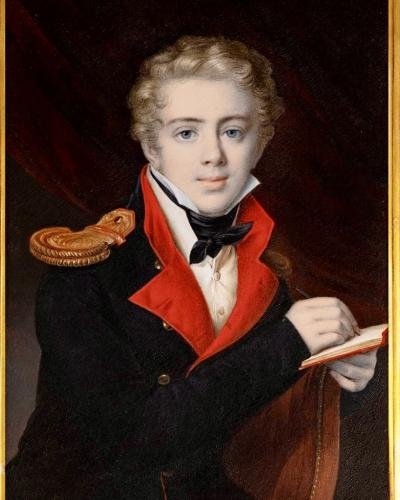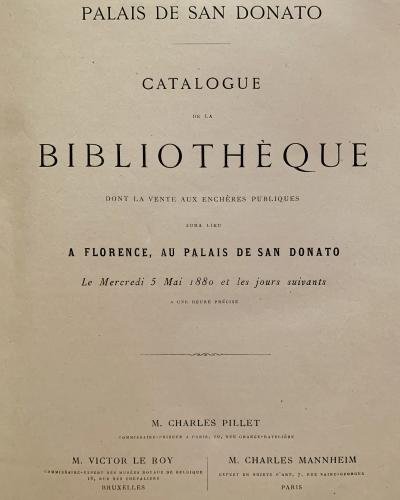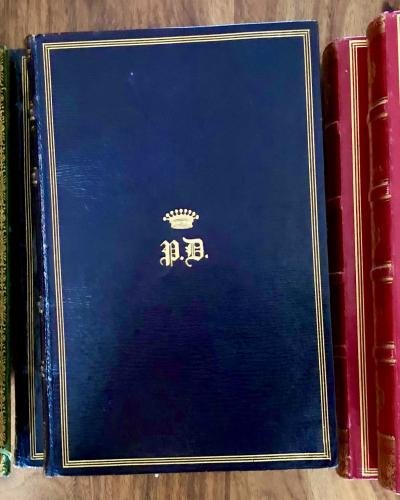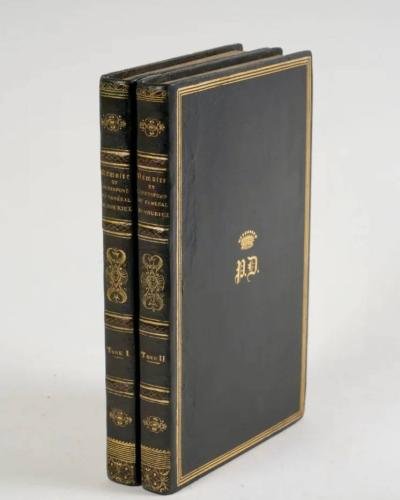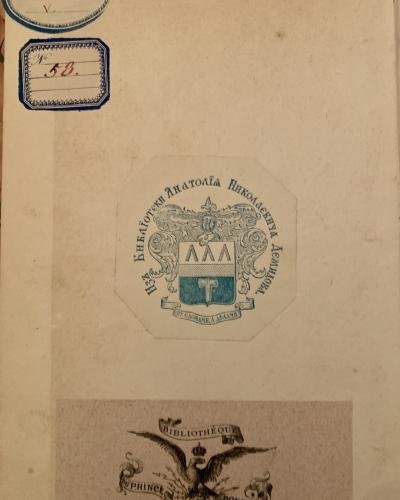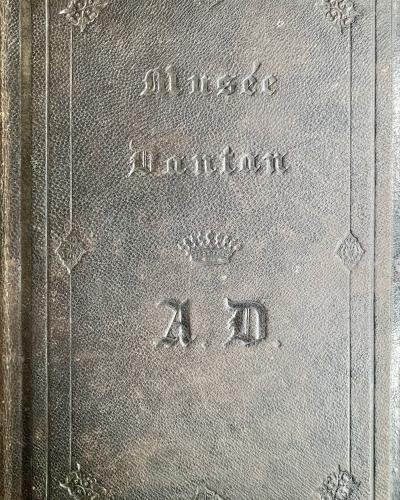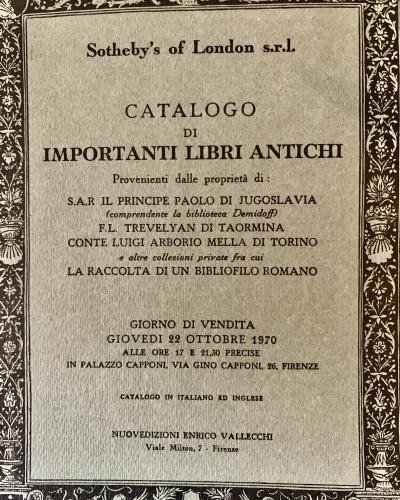The library of the Villa di San Donato was estimated by Cesare da Prato in his 1887 book, Firenze ai Demidoff, Pratolino e San Donato, to contain around 40,000 items. Unfortunately, no records have come to light that document how the contents of the library were assembled and subsequently disbursed. The largest disbursement took place in 1880 at the sale of the library of Villa di San Donato and San Martino where over 6,900 titles were offered for sale. Although a large number, it still represents less than 20% of the contents of the original library. This lack of documentation complicates the process to identify the original Demidoff literary collector as well as the more ambitious goal of completing a virtual reconstruction of the content of the original library.
Nonetheless, it is believed that the original library involved the literary contributions of at least three Demidoff family collectors: Paul Nikolaivitch (1798-1840), Anatole Nikolaievitch (1813-1870, and Paul Pavlovitch (1839-1885). However, new scholarly findings are shedding light on one of its original contributors. Elena Pavlovna Pirogova of the Ural State Pedagogical University (UrGPU) imminently publishes a chapter entitled, 'Bibliotheque de San Donato', in her forthcoming monograph, 'The Private Life of the Demidov Nobility'. In that chapter she makes clear that, “In the library of the Nizhny Tagil Museum of Regional History… amongst numerous treasures of books stand out…with gilt edging done in gold, books with an oval stamp, ‘Bibliotheque de San Donato’… These are the remains of Demidov’s library, which have yet to be studied and presented…”. Pirogova explains that each book is presented in fine, coloured morocco binding, with gold trim throughout, but with no ex libris. What each book does display is a super ex libris in the form of the gold-embossed initials ‘PD’ on the cover surmounted by a crown. Pirogova further states that, “The documents we have discovered clarify the history of these bindings and convincingly prove that behind the initials of the super ex libris is hidden the name of Pavel Nikolaievich, Anatole’s elder brother”.
Pirogova further discovered that Paul Nikolaievitch had separate libraries installed in each of his two properties in Saint Petersburg that occupied three rooms in total. Also discovered was a “Register of Books in the Library Left after the Death of the actual State Councillor, Pavel Nikolaievitch Demidoff”. The register lists 933 titles consisting of 4,937 separate volumes mostly written in French. Around one-fourth of the books were written in Russian (234). The books include the ‘Latin Classics’ translated into French, together with books on History (101 titles), Travel (79), and Biographies (74), amongst others. Unfortunately, the title of each book is only briefly presented, so without detail concerning the author, edition, etc. According to Pirogova, only preliminary research has been undertaken to date leaving ample scope for future interesting discoveries.
Pirogova further believes that the library of Paul Nikolaievitch may not have first passed to his younger brother, Anatole Nikolaievitch, but was transported instead to the library located within the Demidoff industrial complex of Nizhny-Tagil in Russia. In other words, it may have been Paul Pavlovitch who inherited the library of his father, Paul Nikolaievitch, and who then directed the shipment of the books from the Urals to Villa di San Donato and from 1874 to 1876. In addition, Pirogova found evidence that appears to indicate that those books that failed to sell at the 1880 public sale of the library of Villa di San Donato were returned to the Urals.
Pirogova's research findings were recently compared to 79 titles comprised of 171 separate volumes from the library of Villa di San Donato found in a private library in England. An in-depth investigation of the books in the private library led to the attribution of 34 titles to the original library of Paul Nikolaievitch. The books all date to the first half of the 19th Century and are written in French, or in Latin with translation into French. The binding of each volume is long-grain, full-colour morocco leather with triple gilt fillet, gilt spines, and gilt edges. Depending on the subject matter, the colour of the leather is either green, red, blue, black, brown, or cream. Each displays a super ex libris on the front cover showing the gold-embossed initials, ‘PD’, surmounted by a crown. The subject matter ranges from the ancient classics to ‘contemporary’ literature, theology, history, and biography. Due to their superb binding, general excellent condition, and high-quality content, these books regularly come to auction in France and Monaco and command premium prices. The books do not contain any markings that would indicate that the collection at any one time formed part of the library of Anatole Nikolaievitch. However, each book does show the oval stamp, ‘Bibliotheque de San Donato’, that, it is believed, Paul Pavlovitch added to each volume in his library following his inheritance of Villa di San Donato in 1870.
Some of the earliest books attributed to the library of Paul Nikolaievitch include those published by Charles-Louis-Fleury Panckoucke (1780-1844), a French bookseller, publisher and editor. In the early 1820’s, C.L.F. Panckoucke initiated the collection, ‘Bibliothèque latine-française’, a series of expensive books with French translations of Latin classics by ancient Roman authors that published to strong critical acclaim. There are 7 such titles comprising 14 separate volumes from the series in the private library in England. Given the identical copy description of other books from the ‘Packoucke’ series that recently have come to public auction in France and Monaco, it is believed that the more than 20 titles shown under the theme, ‘Classiques Grecs et Latins’, in the 1880 sale catalogue of the library of Villa di San Donato, all pertain to the original library of Paul Nikolaievitch.
It is not surprising that books on the classics would appeal to Paul Nikolaievitch given his early education at the elite ‘Napoleon school’ in Paris. Moreover, as a young man, he would accompany his father, Nicholas N. Demidoff (1773-1828), on archaeological excavations in Rome where important discoveries of ancient sculptures would be made. Paul Nikolaievitch was not only a passionate student of the classics, but also deeply interested in the social and physical sciences. For example, the private collection includes 3 titles from the 63 volume series, ‘Collection des mémoires relatifs à la Révolution française’ as well as the 5 volume publication, ‘Traité de chimie élémentaire, théorique et pratique’, by Baron L.J. Thenard. However, Paul Nikolaievitch is best remembered for creating the ‘Demidov Prize’, an annual prize that he founded in 1831 to promote excellence in scientific research in Russia. In essence, the titles in the private library attributed to Paul Nikolaievitch indicate the tastes of a highly cultured, inquisitive, and learned individual.
In the end, it is clear that the description given by Pirogova of the books pertaining to the libraries of Paul Nikolaievitch in Saint Petersburg match exactly the copy description of the 34 titles attributed to Paul Nikolaievitch found in the private library in England. Unfortunately, the evidence in support of the attribution of books in the private library to Anatole Nikolaievitch (32) and to his nephew, Paul Pavlovitch (13), exists, but in a number of cases, remains less convincing. Nonetheless, it is believed that replicating this kind of investigation at other existing private and public collections of books from the library of Villa di San Donato can only support the attribution process. These collections can be found today at the Geographical Society of France, the Nizhny Tagil Museum of Regional History, and the Uffizi Library in Florence, amongst others. It is further believed that this kind of investigation supports the more ambitous goal of one day completing a virtual reconstruction of the original library of Villa di San Donato.
